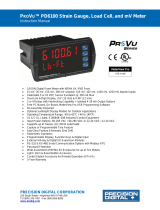Page is loading ...

LCT100
Load Cell Tester
User’s Guide (v1702)
Anyload Transducer Co. Ltd
Website: www.anyload.com
Email:
info@anyload.com

LCT100 Load Cell Tester
1. Connect the load cell cable to the right pins in the connector
2. Make sure that the shield and body are not connected
3. Turn on the unit by pressing on/off key for a few seconds
4. The display will show the welcome screen for a few seconds and
change to ask for load cell type ( 4 or 6 wires )
5. For the most accurate results for the high resistance ( leakage ), this is
the time to run the calibration. Hold both the right key and on/off key,
the display will show Calibrating… After 2 seconds the unit is calibrated
6. Now connect the shield and body ( if available ) to the connector
7. Choose type of Load Cell ( 4 or 6 wires ) and press Enter
8. Choose L/C rated output with the up and down keys and press Enter
9. Press Enter for full testing or, down arrow for continuous display
If continuous mode was chosen:
The LED will blink in various colors and the Load Cell signal will be displayed
continuously in percentage of the full L/C capacity.
For example: applying 10Kg on a 100Kg load cell will show of 10%
Note: To save the battery the unit will shut off after 6 minutes
1 | ANYLOAD LCT100 Load Cell Tester User’s Guide (V1702)

If full testing cycle was chosen:
The LCD shows “ Test in progress” and the LED blinks for a few seconds.
Once the test is finished you may scroll the results by pressing the up arrow
key. The results will be displayed in the following order:
Input – Resistance between Ex+ and Ex- ( Max 5000Ohm )
Output - Resistance between Signal+ and Signal- ( Max 5000Ohm )
Sense+ - Resistance between Ex+ and Sense+ ( applicable for 6 wires load
cell ) ( Max 5000Ohm )
Sense- - Resistance between Ex- and Sense- ( applicable for 6 wires load cell
) ( Max 5000Ohm )
Signal Output – Load cell signal in percentage of full L/C capacity. Note: in
case of a broken cable or a very high input/output resistance the display
will show “ Cannot measure”
Shield to Brdg – Resistance between the cable shielding ( screen ) and the
bridge
Body to Brdg – Resistance between the load cell body and the bridge
Shield to Body – Resistance between the load cell body and the cable’s
shielding
Tips for trouble shooting Load Cell and scales
Load cells might be damaged due to many reasons: Overloading, lightning
strikes, moisture or chemical ingress, vibrations, corrosion, pulling the cable etc.
As a result, the scale may provide unstable readings, zero drifting, error reading,
non-linearity etc.
The LCT100 is the only measuring tool required to perform the tests either on
site or in the lab. Before you start, make sure to have the Load cell spec and the
cable color code (usually you get it with the load cell, or it can be downloaded
from the manufacture web site).
How to test a weighing platform with a few load cells:
1. First stage: Leave all load cells connected to the summing box.
Disconnect the cable from the weighing indicator, connect it to the
LCT100 and perform a test.
2. Expected results for a good scale are as per the following example: If
you have 4 load cells of 1000Ω, 100kg each and 40kg are applied on
the scale than you would expect to see around 250Ω for the input and
2 | ANYLOAD LCT100 Load Cell Tester User’s Guide (V1702)

output (total of the Input resistance divide by 4 and the same for the
Output resistance). In case of six wires cable, you should expect to get
very low resistance between the sense lines and the inputas those are
shorted inside the L/C. Signal output must be around 10% (full scale
capacity is 400kg) and the Shield to bridge resistance must remain very
highi.e. >1000MΩ
3. If some of the expected results are not in the required range, or you
get erratic / unstable readings when testing in Continuous (Gain)
mode: Check the cable integrity between the summing box and the
tester. If it looks fine, disconnect each Load Cell cable and check each
Load Cell separately. Note: there is no need to remove the load cell
from the scale.
4. If all results seem to be in range, you may check for scale linearity, by
choosing Continuous mode (Gain) on the LCT100 and applying various
weights on the scale.
Understanding the LCT100 results:
Testing result with LCT
Possible reasons
What to do?
Input / Output
resistance not in
range
Cable or connector
problem
Check cable integrity
and the
connectors
Problems inside the load
cell
Replace or send for
repair
Sense is Too high (6
wires cell)
Not connected inside
L/C, or it can be 4 wires
Load Cell
Replace or send for
repair
Signal Output from the
scale is not in the
expected range
Corrosion, force shunts,
accumulated dust below
the L/C
or a faulty L/C
Clean the dust and
check force shunts and
alignment. Replace L/C if
necessary
Signal Output not in the
expected range
(Unloaded Load Cell it
should be around 0%)
Load cell zero balance
damaged because of
shock or overload
If the output signal is
still low, the load cell
can be used. A new
calibration will be
required.
Shield to bridge is too
low
Water or chemical
ingress to the cable or
into the L/C
Replace the cable or
repair the L/C
3 | ANYLOAD LCT100 Load Cell Tester User’s Guide (V1702)
/




